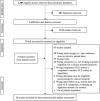A systematic review on natural language processing systems for eligibility prescreening in clinical research
- PMID: 34725689
- PMCID: PMC8714283
- DOI: 10.1093/jamia/ocab228
A systematic review on natural language processing systems for eligibility prescreening in clinical research
Abstract
Objective: We conducted a systematic review to assess the effect of natural language processing (NLP) systems in improving the accuracy and efficiency of eligibility prescreening during the clinical research recruitment process.
Materials and methods: Guided by the Preferred Reporting Items for Systematic Reviews and Meta-Analyses (PRISMA) standards of quality for reporting systematic reviews, a protocol for study eligibility was developed a priori and registered in the PROSPERO database. Using predetermined inclusion criteria, studies published from database inception through February 2021 were identified from 5 databases. The Joanna Briggs Institute Critical Appraisal Checklist for Quasi-experimental Studies was adapted to determine the study quality and the risk of bias of the included articles.
Results: Eleven studies representing 8 unique NLP systems met the inclusion criteria. These studies demonstrated moderate study quality and exhibited heterogeneity in the study design, setting, and intervention type. All 11 studies evaluated the NLP system's performance for identifying eligible participants; 7 studies evaluated the system's impact on time efficiency; 4 studies evaluated the system's impact on workload; and 2 studies evaluated the system's impact on recruitment.
Discussion: NLP systems in clinical research eligibility prescreening are an understudied but promising field that requires further research to assess its impact on real-world adoption. Future studies should be centered on continuing to develop and evaluate relevant NLP systems to improve enrollment into clinical studies.
Conclusion: Understanding the role of NLP systems in improving eligibility prescreening is critical to the advancement of clinical research recruitment.
Keywords: clinical research; clinical trial matching; cohort identification; eligibility prescreening; natural language processing.
© The Author(s) 2021. Published by Oxford University Press on behalf of the American Medical Informatics Association. All rights reserved. For permissions, please email: journals.permissions@oup.com.
Figures
References
-
- Lenfant C. Clinical research to clinical practice—lost in translation? N Engl J Med 2003; 349 (9): 868–74. - PubMed
-
- Gul RB, Ali PA. Clinical trials: the challenge of recruitment and retention of participants. J Clin Nurs 2010; 19 (1–2): 227–33. - PubMed
-
- Lamberti MJ, Mathias A, Myles JE, et al. Evaluating the impact of patient recruitment and retention practices. Drug Inf J 2012; 46 (5): 573–80.
Publication types
MeSH terms
Grants and funding
LinkOut - more resources
Full Text Sources
Miscellaneous


